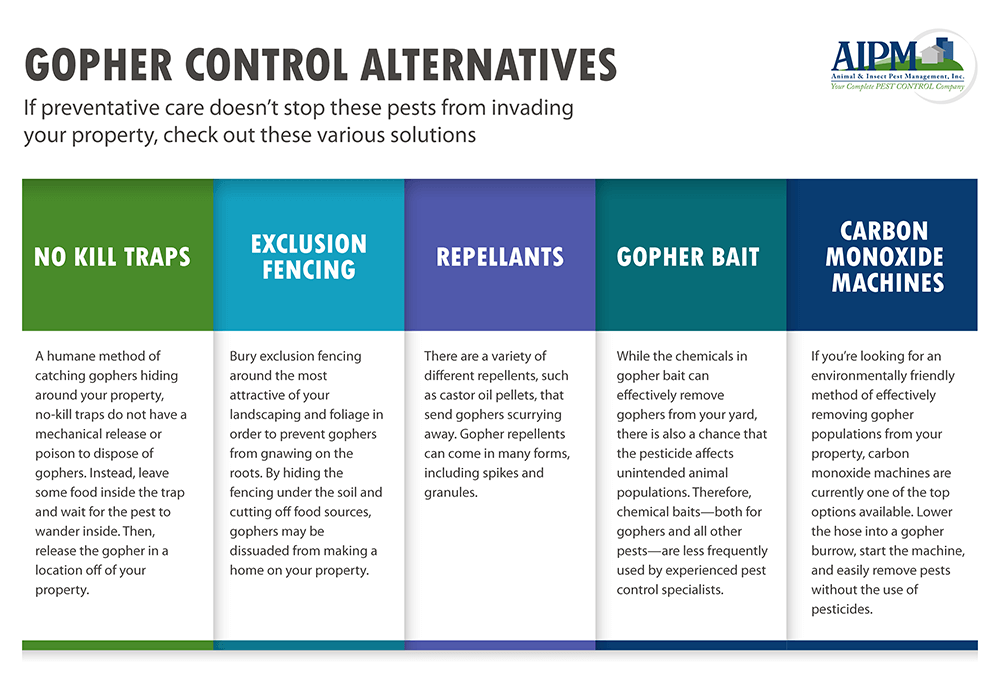These small rodents can cause lots of damage to your property if left untreated. Read on to discover everything you need to know about gophers, plus how to handle them if they invade your yard.
Gophers’ Appearance
Small, furry, and sporting their signature big front teeth, gophers might look cute, but they create a startling amount of damage if not carefully controlled. These burrowing rodents are furry, with large cheek pouches perfect for carrying seeds, nuts, and other food. Their arms and upper body are powerful and strong, capable of digging through the ground and creating tunnels. While the size varies by species, generally gophers are around 6-10 inches long. Their whiskers and powerful incisor teeth aid them in easily digging across the terrain.
Are Gophers Serious?
Gophers are small but mighty. They’ve evolved to be perfect diggers, capable of tearing up carefully constructed landscaping and gnawing through wires and roots with their strong teeth. When gophers invade a property, they feed on crops, plants, vines, trees, and nearly anything they can get their mouth on. As they dig, they can easily tear up grass in a yard, as well as power through water lines, wires, and irrigation systems. Replacing these features can be expensive and time-consuming. In addition to property damage, gophers are wild animals that can transfer disease and cause serious health issues to occur if touched.
Types of Gophers
There are a handful of different types of gophers across the world, burrowing in the dirt and gnawing on plants. California is home to five species of gophers, with the most common species being the Botta’s pocket gopher. While there’s a slight chance that another species of gopher might visit your property, Botta’s pocket gophers are by far the most frequent offender.
Behavior and Diet
Gophers love to dig. They can create several different mounds a day, 6-12 inches below the ground. They do not hibernate and remain active all year round, hunting for food and burrowing. Gophers prefer to live on their own and can be quite territorial when it comes to sharing space. They do not like to dig their burrow system close to those of other gophers. Gophers eat a large variety of different things, including earthworms, vegetables, plants, and other vegetation, and enjoy living in a wide range of habitats.
Life Cycle and Reproduction
Gophers can live anywhere from 1 to 3 years on average. They breed anytime during the year with litters ranging from 2-5 gophers. Once born, gopher pups will stay with their mother for a month before venturing out on their own. These young gophers will reach sexual maturity at around 1 year of age. Gophers will only share their burrows during two occasions: mating season and weaning season. After this period, gophers prefer solitary living.
Gopher Control
If you have gophers living on your property, they can cause an enormous amount of damage—but don’t worry! There are effective and proven methods of removing gopher populations that do not harm environmental surroundings.

To begin with, the most effective form of pest control for any species is always preventative action. Making sure that your home isn’t inviting to pests in the first place removes the need for further pest infestation solutions. When it comes to gophers, they’re drawn to your yard by three factors: food, soil, and shelter. If preventative care doesn’t stop these pests from invading your property, check out these various solutions:
- No Kill Traps: A humane method of catching gophers hiding around your property, no-kill traps do not have a mechanical release or poison to dispose of gophers. Instead, leave some food inside the trap and wait for the pest to wander inside. Then, release the gopher in a location off of your property.
- Exclusion Fencing: Bury exclusion fencing around the most attractive of your landscaping and foliage in order to prevent gophers from gnawing on the roots. By hiding the fencing under the soil and cutting off food sources, gophers may be dissuaded from making a home on your property.
- Repellants: There are a variety of different repellents, such as castor oil pellets, that send gophers scurrying away. Gopher repellents can come in many forms, including spikes and granules.
- Gopher Bait: While the chemicals in gopher bait can effectively remove gophers from your yard, there is also a chance that the pesticide affects unintended animal populations. Therefore, chemical baits—both for gophers and all other pests—are less frequently used by experienced pest control specialists.
- Carbon Monoxide Machines: If you’re looking for an environmentally friendly method of effectively removing gopher populations from your property, carbon monoxide machines are currently one of the top options available. Lower the hose into a gopher burrow, start the machine and easily remove pests without the use of pesticides.
Some of these gopher solutions can be attempted DIY, but when it comes to gopher populations, it’s always best to partner with a pest control specialist. Check out all of the professional services that AIPM provides to valued customers.
